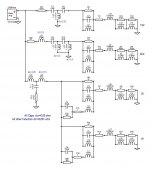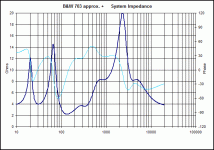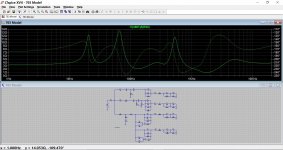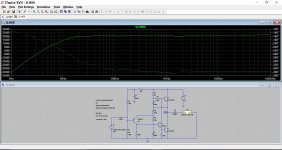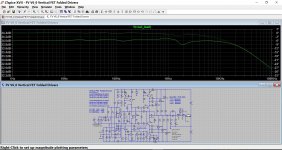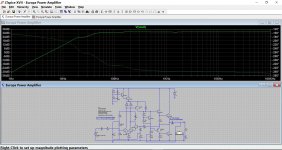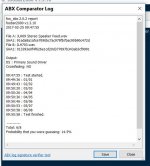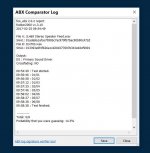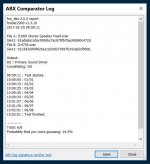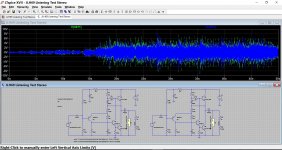I was trying to make a load that was something like my B&W.
Your model has zobel (low impedance at HF) but I cant see it in the crossover?
Simulated B&W 703 system impedance
Found B&W data on Göran's Audio Excite web for the tweeter and woofer which I adopted almost completely except for woofer Re and Le. The FST midrange was traced from Zaph Audio measurements. After that I have been adjusting values in XSim until I thought it matched well enough to the traced plots.
Found B&W data on Göran's Audio Excite web for the tweeter and woofer which I adopted almost completely except for woofer Re and Le. The FST midrange was traced from Zaph Audio measurements. After that I have been adjusting values in XSim until I thought it matched well enough to the traced plots.
Attachments
Hi Mooly and other participating members. I made an interesting choice by choosing amp3 but did not use a PC and headphones. I recorded the wav file and played it through my DAC and daily in use JLH 1969 amplifier and carefully listened to each track several times until I made my choice.
I know my JHL very well, I also designed several amps in the past all class AB and mostly lateral FET.
Does anyone find it interesting that I chose the simulation that is opposite to the actual amplifier I use. Maybe listing to two JLH's in series doubles or squares the effect and is not pleasing.
Anyone for some comment?
I know my JHL very well, I also designed several amps in the past all class AB and mostly lateral FET.
Does anyone find it interesting that I chose the simulation that is opposite to the actual amplifier I use. Maybe listing to two JLH's in series doubles or squares the effect and is not pleasing.
Anyone for some comment?
Interesting thought Nico.
A bit like eating a cream cake, one is very nice, two maybe just a bit to much.
I've often wondered whether we should 'mix and match' more when it comes to opamps, particularly when a design uses several.
That is an interesting thought.
Does anyone find it interesting that I chose the simulation that is opposite to the actual amplifier I use. Maybe listing to two JLH's in series doubles or squares the effect and is not pleasing.
I find this very interesting, and actually raised the same (theoretical) point in xrk971's thread in the SS forum about auditioning a bunch of headphone amps. I might prefer one amp's recording when listening through my headphone amp because I like the combined effect of both amps, but I might not like either amp individually. Sure, listening to all the recordings back-to-back gives some impression about how they compare to each other, but, again, preferring one over another in this virtual audition may not carry over to a preference in real life. Perhaps since we all listen through different gear, that explains, in part, why the votes were essentially an even split.
My feeling is the harmonic profile can be altered quite a bit by effectively chaining the two amps together. Maybe my amp has dominant third harmonic, and I find that the clip I prefer has dominant second. (Actually, this is likely the case since my DAC has an opamp output and I preferred Amp 1, while Amp 3 sounded a bit congested.) Perhaps if I listened through a dominant second harmonic amp, as you did with the JLH, I would prefer Amp 3. Also, we should probably worry about the relative phase of the harmonics, as is often discussed in the Pass Labs forum. Perhaps an amp exhibits a "pleasing" negative phase second harmonic dominant profile. But, if we run it through another amp with similar profile, wouldn't the phase switch twice and give us the perhaps-less-pleasing positive phase dominant second?
All this notwithstanding, I really like the idea of being able to virtually audition my amps from their SPICE simulations and will definitely give this a try in the future. Perhaps to partially alleviate the issue of combined harmonic profiles being non-pleasing, one could listen to the clips through two different (headphone) amps (e.g. one push-pull, one single-ended) while keeping the speakers/headphones constant and then vote for the "average" best.
Last edited:
Perhaps since we all listen through different gear, that explains, in part, why the votes were essentially an even split.
Seems likely. Hard to explain the results otherwise.
It's a shame it wasn't more conclusive. With so few participants I feel that the random element of the listening equipment has had too much of a bearing on the result. I'm not sure if more had taken part this might have been mitigated so some degree? It's just a gut feeling
Using Lojzek's brilliant diagram for my 703's I have created a subcircuit that can be called up.
The results on the JLH are interesting and the varying impedance of the load certainly upsets the response. The Europa looks amazingly good considering. Go figure that one out . The FET amp... well look at the scale before judging.
. The FET amp... well look at the scale before judging.
All interesting stuff. I must try my relatively simple lateral FET design in all of this at some point.
The results on the JLH are interesting and the varying impedance of the load certainly upsets the response. The Europa looks amazingly good considering. Go figure that one out
All interesting stuff. I must try my relatively simple lateral FET design in all of this at some point.
Attachments
I was curious to try this simulated load and so I picked the JLH as guinea pig 
Three Foobar results all came out the same, maybe I was losing focus at the same point lol When you flip between the two versions there does seem to be a difference but its subtle. In some ways the tough load seems to give a more expansive sound stage, better left/right separation perhaps, which is plausible if you imagine the load distorting the different info in the left/right channels. I also felt the dynamics were softer with the tough load, and at one part where the vocal comes in (this bit)
When you flip between the two versions there does seem to be a difference but its subtle. In some ways the tough load seems to give a more expansive sound stage, better left/right separation perhaps, which is plausible if you imagine the load distorting the different info in the left/right channels. I also felt the dynamics were softer with the tough load, and at one part where the vocal comes in (this bit)
It was almost as if there were a limiter in place (like the old auto level control on cassette decks). Very subtle but there non the less.
This is the tough load file (Dropbox) and the original 8 ohm test.
Tough Load Test
Three Foobar results all came out the same, maybe I was losing focus at the same point lol
From these rivers of headlights, these rivers of rain
From the anger that lives on the streets with these names
'Cause I've run every red light on memory lane
It was almost as if there were a limiter in place (like the old auto level control on cassette decks). Very subtle but there non the less.
This is the tough load file (Dropbox) and the original 8 ohm test.
Tough Load Test
Attachments
Mooly, did you use the improved 240/9240 models with subthreshold conduction?
Those effects are there but at audio frequencies they are smaller than almost anything else. Reflections in the 20MHz+ range won't have any noticeable effect on audio and the cable acts just like an inductor and capacitor, the capacitance also having no distinguishable effect at audio, from a measurements perspective. At audio frequencies there is virtually no EMF between the ends of the speaker cable so transmission line effects don't get any energy to start with.
Inductance, resistance and possibly skin effect are the things that I think could possibly have an audible and measurable effect (which does not include audible and not measurable, measurable and not audible, or not measurable and not audible).
You can look over this very good article by Nelson Pass on the subject:
https://passlabs.com/press/speaker-cables-science-or-snake-oil
This has been tossed around a lot in other topics, but speaker cables can act like transmission lines at higher audio frequencies. Even cables a short as 6 feet long exhibit transmission line behavior. And getting around that issue at audio frequencies is very difficult. Typical transmission line equations are not accurate at audio frequencies is a related problem, since the equations are simplifications of Maxwell's equations using assumptions good only at RF frequencies.
Anyway, it means there are phase shifts at high frequencies that aren't accounted for by lumped models of crossovers and speakers.
Our old friend jneutron is the expert on this.
Those effects are there but at audio frequencies they are smaller than almost anything else. Reflections in the 20MHz+ range won't have any noticeable effect on audio and the cable acts just like an inductor and capacitor, the capacitance also having no distinguishable effect at audio, from a measurements perspective. At audio frequencies there is virtually no EMF between the ends of the speaker cable so transmission line effects don't get any energy to start with.
Inductance, resistance and possibly skin effect are the things that I think could possibly have an audible and measurable effect (which does not include audible and not measurable, measurable and not audible, or not measurable and not audible).
You can look over this very good article by Nelson Pass on the subject:
https://passlabs.com/press/speaker-cables-science-or-snake-oil
Mooly, did you use the improved 240/9240 models with subthreshold conduction?
Those effects are there but at audio frequencies they are smaller than almost anything else. ....
You can look over this very good article by Nelson Pass on the subject:
https://passlabs.com/press/speaker-cables-science-or-snake-oil
I didn't find anything new in the Nelson Pass article, but it might be a good introduction for those new to the subject.
Here are some links to a few of jneutron's posts on the subject, which are what I was thinking of before:
http://www.diyaudio.com/forums/loun...ch-preamplifier-part-ii-8751.html#post4815183
http://www.diyaudio.com/forums/loun...ch-preamplifier-part-ii-8698.html#post4804861
http://www.diyaudio.com/forums/loun...ch-preamplifier-part-ii-4646.html#post3767217
http://www.diyaudio.com/forums/ever...scussion-loudspeaker-cable-21.html#post663909
Anyway, the reason I mentioned the effect here has to do with trying to model amplifiers with a high degree of accuracy. In some installations, people may use rather long speaker cables. In such cases it may be of interest to see how that might affect the models Mooly had been working on. And that more from a perspective of completeness than concern. In a living room situation cables are usually fairly short.
However, for professional use of amplifiers, speaker cables may sometimes be more than 100' feet long. The longer they get, the less accurate some approximations are likely to be, particularly those of the arm-waving type.
Last edited:
- Status
- This old topic is closed. If you want to reopen this topic, contact a moderator using the "Report Post" button.
- Home
- Member Areas
- The Lounge
- Welcome to the (virtual) listening room.
